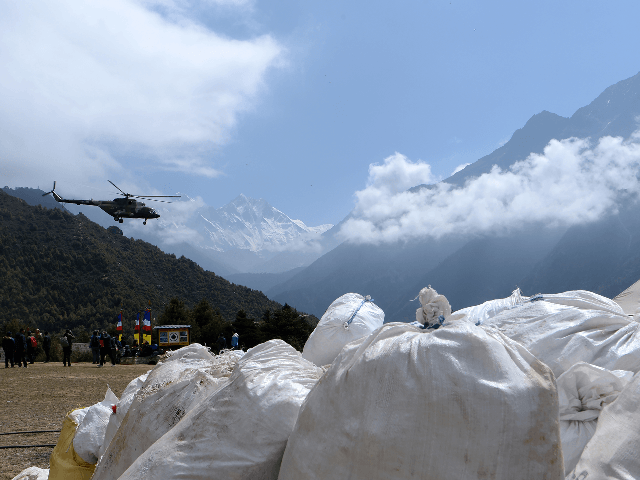The communist regime of China, which controls the north face of Mount Everest, used its Xinhua news arm to call for more regulation on Nepal’s side of the mountain on Tuesday, citing the “chaos” triggered by Kathmandu offering too many permits to climb for a higher death toll and growing litter problem on the world’s tallest mountain.
China and Nepal share an agreement to split the mountain; the summit acts as the border between the two countries. The north face of the mountain, controlled by China, typically sees many fewer climbers as it is considered more challenging and China has stricter requirements and gives out fewer permits than Nepal.
Noting that 11 people have died this year trying to climb Everest already, Xinhua demands “stricter regulations,” citing sherpas who complain that too many people are crowding the routes up. Two of the 11 deaths occurred on the Chinese side.
“According to a code of practice in Nepal, a climber must scale a peak of at least 6,000 meters before climbing Mt. Qomolangma, but many inexperienced climbers can easily get permits due to mismanagement,” Xinhua notes, calling the resulting situation “chaos.” “With these green hands taking more time to move ahead by a single rope fixed on a shape-edged slope amid strong wind, they are not just risking their own lives but also of others by forcing them to wait in extreme weather conditions.”
The article quotes a Nepali journalist who suggests that Nepal’s regulations should be more like China’s, imposing more rigorous penalties on climbers who litter on the mountain.
It is not the first time that China makes a similar call for Nepal to emulate it. The Global Times, a government newspaper, made almost an identical argument to Xinhua’s in late May, following the publication of several stories in Western media exposing corruption and poor management on the Nepalese side of the mountain.
As the New York Times reported that month, Nepal had handed out increasingly bigger numbers of permits annually, leading to a situation in which the narrow path to the summit was too crowded and inexperienced climbers were creating dangerous situations for everyone else. Some who climbed to the summit said they witnessed poor sportsmanship and disregard for the lives of others from many of the climbers, and some even had to pass by dead bodies on the way to the top.
In contrast to the larger number of tourists attempting to reach the top in Nepal, China shut down its base camp to tourists in February, as the spring climbing season loomed, and instead refocused its efforts on attracting master climbers frustrated by the crowding in Nepal. China had banned all individual climbers, as well, claiming the route was too risky to take alone. China also limited the number of permits in 2019 to 300 and imposed a $1500 fee on each climber to clean up litter along the route.
That month, the South China Morning Post noted that China was “investing millions to boost a rival path to the top of the world.” China now allows helicopter rescues on the mountain, unprecedented for Everest’s north face, and is building a new climbing training center in the area. China also announced that it would begin rehabilitating rope systems that needed repair to help climbers reach the top.
Even before the wave of deaths and harrowing eyewitness testimonies appeared in Western media this year, companies that organize group climbs to the summit and cater to expert climbers had begun taking a chance on the more difficult Tibetan climb. Lukas Furtenbach, who runs one of the companies, told the Morning Post that the Nepalese side was “absolutely intolerable” due to the overcrowding and presence of inexperienced climbers now.
China’s relationship with Nepal has remained stable despite the competition, and friendlier than last year, when China accused Nepal of artificially inflating the height of the mountain. China insisted that the summit should be counted only as the rock that forms the mountain, not including the thick layer of snow covering it, a difference of about 12 feet. The two countries had already agreed on Nepal’s measurement in 2010.
China has not challenged Nepal’s claim to part of Everest in modern history. Communist dictator Mao Ze Dong attempted to convince the Nepalese to share territorial control of the mountain and rename it “Friendship Peak,” which Nepal rejected. China’s sovereignty over Tibet, however, is in greater dispute. There is no Han Chinese traditional name for the mountain, and while China claims Tibet as a rogue province, those who advocate for Tibet as its own nation refer to it as a sovereign state under Chinese “occupation.” China brutally represses Tibetan Buddhism and, like with all its national minorities, imposes Han culture and language, and loyalty to the Communist Party, over Tibetan locals.
Just as China began reinvesting in Everest, it allowed U.S. Ambassador Terry Branstad to visit Tibet in May, the first such visit since 2015. Chinese authorities claimed they did so to show Branstad “the major changes which took place in Tibet for past 60 years after the peaceful liberation,” the term the communists use for their repression of the local populace.

COMMENTS
Please let us know if you're having issues with commenting.